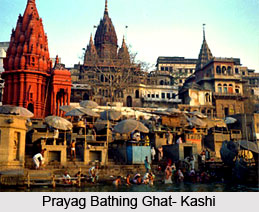 Kashi is an example of a place of sanctity. Kashi includes all the other tirthas within itself. The presence of all tirthas in Kashi is more than a matter of literary tribute. Many places of pilgrimage are part of Kashi`s sacred geography. Kashi is a cosmopolitan city.
Kashi is also considered as the city of Lord Shiva. The winter months of Marga Shirsha and Pausha are prescribed for a pilgrimage to Kashi. In Kashi, Dwaraka is situated in the Shankhoddhara in the southwestern outskirts.
Kashi is an example of a place of sanctity. Kashi includes all the other tirthas within itself. The presence of all tirthas in Kashi is more than a matter of literary tribute. Many places of pilgrimage are part of Kashi`s sacred geography. Kashi is a cosmopolitan city.
Kashi is also considered as the city of Lord Shiva. The winter months of Marga Shirsha and Pausha are prescribed for a pilgrimage to Kashi. In Kashi, Dwaraka is situated in the Shankhoddhara in the southwestern outskirts.
Four abodes of Kashi
Kashi contains the four abodes of the gods at the four directional points of India. These are all ancient shrines and were given emphasis in the ninth century when the great philosopher Shankara travelled around India. Kashi, the place of divine light, is an abode par excellence. The northern refraction is called Badrinath, a Vaishnava site located in the Himalayas. Badrinath is opened only during the summer months and it is on of the popular pilgrimage places. In Kashi, Badrinath is placed at Nara-Narayana tirthas which is in the northern sector of the city between Gaya and Trilochana Ghats. In Kashi Rameshvaram is presented in three different places: the temple at Rama Kund in central Kashi, the village of Rameshvara on the Panchakroshi Road, and the shrine of Rameshvara at Man Mandir Ghat. As for the refractions of the Divine in west India there is Dwaraka, the western abode in Gujarat. In the east is the temple of Lord Jagannath in Orissa. In Kashi, the similar site of Puri is now near Asi Ghat, in a large rural temple compound. The pilgrimage to these four pilgrimages of India is well known. In Kashi, the presence of the four abodes is an impressive fact of the city`s sacred geography.
Shiva lingas at Kashi
The twelve of India`s lingas of light are located in Kashi, and their presence adds to the dignity and weight of India`s mightiest tirthas. The temple of Somesvara is located on the seacoast in the western peninsula of Gujarat. In Kashi, Somesvara is located just to the north of Dashashvamedha on the heights of Man Mandir Ghat. Also present in Kashi is Mahakala, the `Great Lord of Death`, whose linga of light is located in the city of Ujjain. From eastern Bihar comes the Vaidyanath, the `Lord of Physicians`. In Kashi, Lord Vaidyanath is located in the Kamaccha area and is the most important linga. The linga of light called Bhima Shankar is located in two places. One is in Maharashtra and the other is near Guwahati in Assam. In Kashi it is the famous temple of Kashi Karavat in Kachauri Lane where the linga is located some twenty feet below the ground. Among the other lingas of light in Kashi are two great lingas: Kedara from the high Himalayas, and Omkara located on an island in the Narmada River in Madhya Pradesh. The Vishveshvara linga is in Kashi. Kashi includes all the other lingas of light.
 Other tirthas of Kashi
Other tirthas of Kashi
Prayaga is one of India`s most famous pilgrimage sites. The name means the Sacrifice. It is located at the confluence of the rivers Yamuna and Ganga. The sacred underground river Sarasvati is also said to emerge at the confluence called the Triveni. People come to Prayag to bathe during the month of Magha and every twelve years hundreds and thousands attend the Kumbha Mela.
In Kashi Prayag is located Prayaga in two places. The first is Prayaga Ghat which is on the riverfront that is adjacent to Dashashvamedha. The second place is Panchaganga Ghat. There are several temples of Lord Vishnu in the original Prayaga. Likewise in Kashi too there is a temple site of Bindu Madhava atop the great flight of steps of Panchaganga.
Along with Prayaga, other tirthas include Kurukshetra, the holy `Field of Dharma`, where the war of the Mahabharata was fought which is located in southern Varanasi. There is also the Kamakhya Devi temple in Assam. In Kashi, she resides in a small temple and an entire section of the city is named `Kamaccha`. Some of the tirthas that have come to Kashi are among the most sacred sites in the city. The important thing about the location of these tirthas in Kashi lies in the fact that they need not be visited at all. All these tirthas contribute to the glory of Kashi. When a pilgrim comes to Kashi all these sacred places are visited at one time.
Kashi is considered as the place where all gods reside and where all sacred rivers flow. There is no other place in India that is the host to the countless sacred powers that have been gathered in Kashi.



















